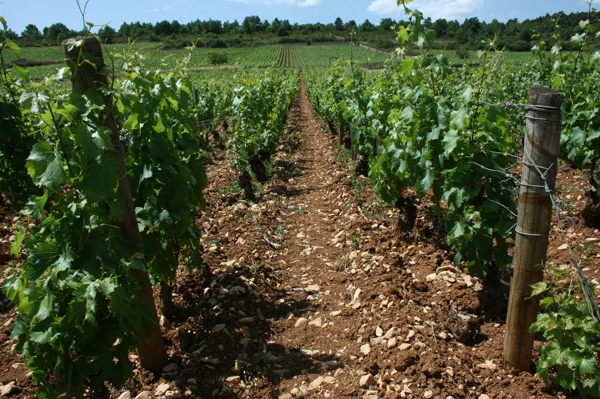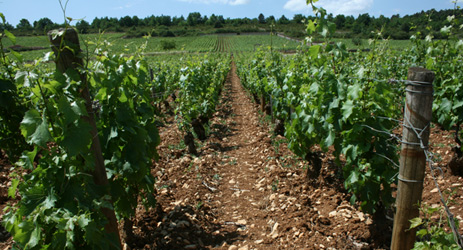Jefford on Monday
The concept of vintage fidelity is an intriguing one. Is it an absolute or a relative ideal? Some see it as a kind of annex to terroir: truth to vintage, the argument runs, is as important as truth to place.
All well and good in a great vintage, of course; we’re all in favour of maximum fidelity then. But what about a dismal vintage, like Bordeaux in 2013, Châteauneuf du Pape in 2002, or Burgundy in 1992? Ought you to make the most atrocious wine possible, in order not to bear false witness to the year?
Of course not. You struggle to make the best wine possible in order to conceal the poverty of the vintage to the maximum extent. What you then want is minimum truth to vintage. This clear-cut case illustrates the relativity of the ideal.

So why ‘intriguing’? Simply because most vintages lie somewhere in the middle of the spectrum. The ideal then becomes ambiguous; it’s up to each producer to find their own place within the matrix of possible vintage interpretations. The 2003 vintage in Burgundy provides a good example.
This, you’ll remember, was the warmest year in Burgundy (researchers for Nature concluded) since 1340. Gevrey grower Jean-Marie Fourrier also owned, back then, some vineyards in Faugères in the Languedoc. He noted three August days over 40˚C in Faugères -- and 17 August days over 40˚C in Gevrey.
The Côte d’Or was truly a côte rôtie in 2003. Harvest began in mid-August, and unfolded at breakneck pace. The young wines, shown in early 2005, were puzzlingly various: some splendidly well-constituted; some confused and unbalanced. Classicists shook their heads at the modest acidity levels combined with extravagantly ripe fruit, and said they would never last. Optimists, though, remembered 1947 and 1959, and wondered if this might be a superheated modern-day re-run.
When in Hong Kong recently for the Decanter Asia Wine Awards, I was lucky enough to be invited to a dinner of scrutiny for a selection of top 2003 Burgundies, plus a couple of Champagne interlopers. One of the collectors presenting wines that evening, John Chow, is a 2003 enthusiast. ‘I’ve loved these wines,’ he said, ‘and I’m sure they’re not going down any time soon. I’ve not had an ’03 that I didn’t like. Among the reds, that is – the whites are nearly a reverse of that feeling. Whereas I’ve not had a red ’04 that I did like.’ Others, though, weren’t so sure. And -- aside from overall quality -- did the wines still demonstrate their site characteristics? Here’re some jottings from my notebook (the wines were served blind).
Dom Pérignon Rosé 2003 and Krug Clos du Mesnil 2003
Our palates limbered up with these broad-shouldered Champagnes. The pink DP was soft, plump and mellow, as close as fine Champagne ever gets to imitating a beached seal (90); the Clos du Mesnil smelled of hops at first and seaweed later, and tasted gentle and mellow, too: hay, salt, kelp (91). Both were, in architectural terms, decidedly Romanesque rather than the Gothic of classic Champagne – but you couldn’t fault their truth to season.
2003 Corton-Charlemagne, Louis Latour and 2003 Corton-Charlemagne, Coche-Dury
The Latour had premox issues, and said little for itself: a full-bodied but uneventful white wine of muted character (85). The Coche was better, with a scent of soft hay and summer flowers at first, and later cake crumb; on the palate it was quiet, close-grained, and creamy, just melting into hazel fullness at the end (92). I had imagined that virginal Corton-Charlemagne might ‘Meursaultise’ and vamp it up in a hot vintage like 2003, but this wine scotched that theory: Corton-Charlemagne’s tell-tale discretion and restraint was still there (if with a little less tension than usual).
2003 Gevrey-Chambertin, Rousseau and 2003 Charmes-Chambertin, Dugat-Py
The Rousseau was a village ringer in a Grand Cru tasting, but it showed well: warm, mellow and tongue-coating, with melting tannins. Accessible, but plenty of road left to run (89). The Dugat-Py was more exciting: dark, structured and deep, with force and thrust, and no sense whatsoever of exaggerated vintage warmth (93). If you’re lucky enough to have any, don’t hurry.

2003 Musigny, J-F Mugnier and 2003 Bonnes Mares, de Vogüé
Two palely coloured but gorgeous wines: the fierce warmth of 03 had not in any way annihilated the caressing quality of Chambolle’s Grands Crus, though it had brought them extra flesh. Mugnier’s Musigny was full-lipped, creamy and tongue-coating, its slow currents and eddies of flavour churning mysteriously (95); the de Vogüé Bonnes Mares was more floral graceful in scent, and burry and autumnal in flavour. It had a hint of incense, too, which we came to realise was characteristic of this vintage (94).
2003 Clos de la Roche, Lécheneaut; 2003 Clos de la Roche, Cuvée Vieilles Vignes, Ponsot (magnum); 2003 Clos de la Roche, Dujac and 2003 Clos St Denis, Dujac
A Morey quartet: the Lécheneaut was gorgeous (supple, soft and upholstered, yet fresh and graceful, too: 94) and the Dujac even better: perhaps the most commandingly structured wine of the evening, with an unrivalled athleticism and range of allusions, yet perfumed from start to finish (95). The Ponsot, by contast, was a disappointment: awkward and rather charmless, with canned-fruit rather than fresh fruit notes (88, if this magnum was typical). Dujac’s Clos St Denis didn’t have quite as much expressive width as the Clos de la Roche, but made up for it with a still more exotic style (rose petals and sandalwood: 94).
2003 Romanée St Vivant, Hudelot-Noëllat and 2003 Richebourg, Grivot
The Hudelot-Noëllat was another highly seductive effort: a richer wine than this vineyard usually manages -- yet with its distinctive balletic poise, too, and haunted by frankincense (95). I remembered how difficult, fierce and almost punishingly tannic the Grivot 2003s had been to taste when first shown in 2005. This was the darkest and most forbidding wine on the table, locked, bolted and strapped up like a pirate’s treasure chest, and neither ethereal nor even particularly charming at present, though impressive (91?). Will it blossom in 30 years, or will it stay locked and strapped for ever?
2003 Criots-Bâtard-Montrachet, Fontaine-Gagnard and 2003 Montrachet, Marquis de Laguiche (Joseph Drouhin)
Two whites to finish. Both were richer and more expressive than the Corton-Charlemagnes had been, and the Criots in particular was a splendid white Burgundy: shapely, layered and textured; citrus-lifted as well as rich; and now in expansive mood (94). The Montrachet, by contrast, was less alert and less concentrated, but its snowfall of oatflake and hazel flour was undeniably classy and gratifying (91).
Conclusions? The white 2003s always looked precocious, and it’s hard to see reasons to hold any of them longer; you may in any case be too late. The reds, though, are a different matter. The challenges of the vintage continue to deliver inconsistent results, but the best are splendidly nourishing and aimiable red Burgundies whose constitution is proving more robust than the pessimists predicted. No Burgundy of this level can be said to be ‘attractively priced’ any more, but some top growers’ ‘03s can be had for much less than the ‘05s, ‘09s and 10s from the same cellars. Perhaps truth to vintage is even more evident in 2003 than truth to place – but that doesn’t mean that the sense of site has gone missing. It’s there, arms flung wide and reclining.
Translated by Sylvia Wu / 吴嘉溦
All rights reserved by Future plc. No part of this publication may be reproduced, distributed or transmitted in any form or by any means without the prior written permission of Decanter.
Only Official Media Partners (see About us) of DecanterChina.com may republish part of the content from the site without prior permission under strict Terms & Conditions. Contact china@decanter.com to learn about how to become an Official Media Partner of DecanterChina.com.



Comments
Submit